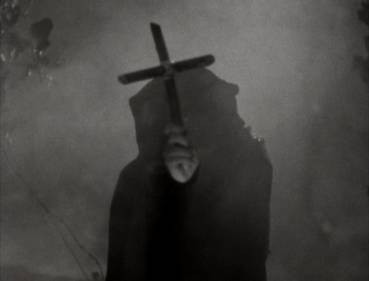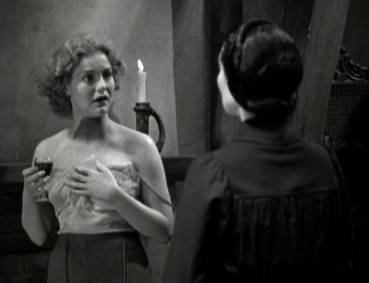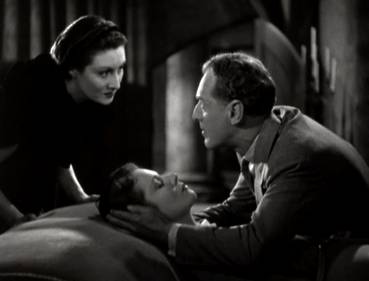|
It
is almost inevitable that sequels will fail to live up to
the originals that spawned them, and though this is also
the case when dealing with most of the follow-ups to Tod
Browning's 1931 Dracula,
the first of them, Dracula's Daughter,
is, for some of us dedicated genre fans, actually superior on
many fronts. Despite being the first sequel to the film
that set the trend for vampire movies for years to come,
Dracula's Daughter plays with the formula
in a number of intriguing ways and is a faster paced
and altogether more involving work than is forebear.
A
phenomenally important film in the development of the vampire
genre, Dracula has not stood
the test of time as well as it's Universal horror contemporary, Frankenstein. Crucially, director James Whale's own sequel
to Frankenstein, Bride of Frankenstein,
is now regarded as not only superior to the original, but
the finest film in the Universal horror cycle and
a cinematic classic in its own right. A box office smash
at the time, its success in some ways led to the second
wave of Universal horror films, many of which were sequels to earlier successes. Dracula's Daughter
was originally set to be a fully fledged sequel to Dracula with Lugosi reprising his role as the Count, while James Whale, who
was on a roll after Frankenstein, The
Old Dark House, The Invisible Man
and Bride of Frankenstein, was scheduled to
direct. But following a very adverse reaction in the UK to the violence
and gleeful sadism of the previous year's The Raven
and the increasingly restrictive nature of the
Production Code in America, Universal were looking to reduce their horror
output. Dracula's Daughter was the first
casualty of this policy change – the budget was cut, Whale
and Lugosi departed, and what was originally planned as a
major production instead became a supporting feature.
All of which sounds like a recipe for a cheapjack knock-off,
but a combination of inventive writing, smart direction
and some workmanlike performances lift the film way above
its supposed second-feature status and mark it as a vital
work in the development of the vampire genre.

The
story picks up exactly where Dracula left off, though the
great expanse of the dungeons of Whitby's Carfax Abbey has been reduced here to the size of a roomy cellar. No matter,
Van Helsing has dispatched Dracula via a stake through the
heart, and for those familiar with the first film, there
are two plus points: Van Helsing is again played by Edward
Van Sloan, and this time the results of his endeavours are
visually evidenced – no off-screen groans here, we can plainly
see that Dracula is dead and how he was killed. Enter two
local bobbies and – hooray – one of them is played by a British actor with a believable accent
(Universal regular E.E. Clive) as opposed to Charles K. Gerrard's Dick Van Dyke-like
cockney asylum guard in Dracula. But then
bobby number 2 opens his mouth and – groan – he's the dim-witted
comedy relief (see also 1940's The Mummy's Hand for a
further example of the distractingly unfunny
comedy foil). Fortunately, he's not in the film that much. More surprisingly, nor is Van Helsing – after being arrested
for the murder of the Count, he disappears for much of the
subsequent screen time and is restricted to offering warnings and
advice when he does appear.
A short while later, the title character enters
the story, followed not long after by the somewhat inevitable
hero and his girl. Familiar characters they may be,
but they are considerably more lively than their equivalents
in Dracula, where lead actor David Manners was given almost nothing to do as the close-to-useless Jonathan Harker. In Dracula's Daughter,
Dr. Jeffrey Garth and his assistant and would-be girlfriend
Janet Blake are pushed much more to the fore and are briskly
performed by Otto Kruger and Margueritte Churchill. Their
sometimes sparky banter echoes the wisecracking lead characters
of a good many romantic comedy-dramas of the period and even the odd horror film, a personal favourite being Glenda Farrell's smart-talking reporter in Michael
Curtiz's 1933 Mystery of the Wax Museum.
Young
mistress Dracula herself, or Countess Marya Zaleska as she
chooses to be known, is played with cool austerity by Gloria
Holden and given plenty of screen time, and rightly so.
Her very introduction throws up some interesting questions
regarding vampire lore, as until very recently,
few genre films have even touched on the idea of vampires
having offspring or families – they were always portrayed
as lone figures who took on brides, usually against their
will, in a relationship that is suggested to have more to
do with blood and dominance than procreation. The idea that
their undead loins could produce little vampires is in itself
subject for an interesting text but is not touched on here – Dracula had a daughter and she's turned up to claim the
body of her old, dead dad, and that's all we need to know. So the film
scores a genre first with the introduction of a vampire
offspring. But hold on a minute, there's another in the
screen's first female vampire, at least the first independently
minded one, as Dracula's brides were merely background characters
under their master's control. When Marya takes a shine to Garth, we
have a most interesting reversal of the Dracula
tale, with the female vampire fixating on a potential male victim. A third feature that was to become a genre trope is Marya's moody, hulking manservant Sandor.
He's not the laughing madman of Dwight Frye's Renfield, but a
physically imposing and protective figure who accompanies
Marya everywhere and removes any obstacles that stand in her way, as
well as procuring potential victims and cheerlessly reminding
her just who she is when she is at her most optimistic.
This was a character that was to re-appear in many later
vampire tales, including Hammer's 1966 Dracula,
Prince of Darkness and Robert Bob Kelljan's 1970
Count Yorga, Vampire, as well as being
sent up nicely in Roman Polanski's 1967 Dance of
the Vampires.

Marya
differs from her father in that she is desperate to escape
her fate as a vampire and become human, something she believes
she can do by burning he father's body and purifying it with
salt. Just to make sure he's sorted, she concludes the deal
with a crucifix. A now familiar slice of vampire iconography,
its use here will likely prompt genre enthusiasts to raise their eyebrows for two good reasons. First up, Dracula
and the films that followed established that the crucifix
does not just prompt vampires to turn away in fear, but
will actually cause physical harm if brought into contact
with vampire flesh, and yet Marya is able to safely wield this
one bare-handed simply by averting her eyes. Secondly, the
cross here is not the cast metal crucifix that prompted Dracula
to dive under his cape in the earlier film but an improvised one constructed from wood and twine. Aficionados will know
that it was Hammer's 1958 version of Dracula
that dared to suggest that improvised crucifixes could
be as deadly as the real deal, yet here we are in 1936 and
the lore is already being messed with in similar fashion. Except that when
you put these two elements together you get an interesting
generic dilemma – either the vampire is able to hold this
cross because a home-made (and thus unsanctified) crucifix
is ineffective against her, and by association her father, or Marya is not a real vampire after all,
just someone who believes she is. And you can read it which ever way you choose, as both interpretations work
for the story. Marya uses the cross as a tool
to free her of her father's curse, yet she is not free of
it – is this because she used an ersatz tool instead of
one that would have finished the job? Alternatively, if
she is not a real vampire then Dr. Garth's attempt
to psychoanalyse her in order to understand and perhaps
cure her condition makes perfect sense. This subtextual
suggestion that Marya may just believe she is a
vampire and that the condition can be cured through psychiatric
means instead of slamming a stake through her heart prefigures
George Romero's Martin – which explored
similar territory in more depth – by forty years. And
if she is a vampire, then she is the first film character
in the genre to improvise here her own crucifix, and one of the very
few vampires to use it against her own kind.
But
the most startling new element, given that the film was
made during the censorious days of the Production Code, is the
twist given on the sexual subtext that is so central to
the genre. It's not that we have a female
vampire seducing a male victim – which alone would
have been unusual for its day – but that this female vampire also seduces a female victim. And if the homo-erotic overtones of Count Orlock's
attacks on Hutter in Nosferatu and the
bedroom vistitations in Dracula are indistinct
enough to be open to both interpretation and counter-argument,
the seduction here leaves a lot less to the imagination. Homeless
Lili is invited to Marya's studio on the pretext of being
paid to pose for a portrait that requires the removal of
clothing, and once Lili has complied, Marya gazes at her
with a look of hungry longing that makes the sexual subtext hard to ignore. When she advances on her and the camera
tilts rapidly upwards to the sound of the girl's screams,
it's difficult to believe that all she had in mind was a
quick nibble on the neck.

The
lesbian vampire, of course, has its roots in Sheridan Le
Fanu's novella Carmilla, which was written in 1872,
twenty-five years before Stoker completed Dracula.
But in 1936, even the suggestion that a screen character
might be anything but wholesomely heterosexual was
virtually unthinkable, and the fact that this scene seems to have
gone unmolested seems in retrospect extraordinary.
We were into the 1960s before Jean Rollin began exploring the notion of the lesbian vampire more overtly, and 1970 before Hammer got on board with its own Le Fanu-influenced The Vampire Lovers.
Dracula's
Daughter lacks Lugosi's presence, makes surprisingly
little use of Van Sloan, and does not have Dracula's
primal battle of good against evil, but elsewhere this sprightly
sequel scores some serious points over its predecessor. Niftily
shot and edited – including an almost manic montage sequence
towards the end – and with generally robust performances,
the dialogue is at the very least serviceable and often
much better than that, and does boast its share of memorable lines:
"Possibly there are more things in heaven and earth
than are thought of in your psychiatry," Marya tells
Garth at a dinner party when he dismisses the idea of vampires as superstition,
and when Police Commissioner Sir Basil Humphrey, all of
a fluster for having been dragged from cataloguing his stamp
collection, informs his manservant that he needs his gun
because his is to go out hunting for vampires, the man's
dry response is that suggest that one usually goes after
them with cheque books. Marya also gets to repeat one of
Dracula's most famous lines – "I never drink...wine" – with almost disarming off-handedness, and the audience
is reminded of a key piece of genre iconography when Garth,
irritated at Janet for crookedly fixing his bow tie, claims
that Marya's abode is "the first woman's flat I've
been in that didn't have at least twenty mirrors in it."
The
final ten minutes (major spoilers ahead) may be familiar in narrative terms – the chase
to rescue the kidnapped girl – but screenwriter Garret Fort
and director Lambert Hillyer add a thematic freshness by
making the whole scene not about confrontation or the triumph
of good over evil, but about love and sacrifice. Jeffrey
flies to Transylvania and risks his own life in an attempt
to rescue Janet, whom Marya, aware that she can never be
freed from the curse of her father, has kidnapped in
order to persuade Jeffrey to spend eternity with her, something
Jeffrey is willing to do if it will spare Janet's life.
Sandor meanwhile, who has presumably for some years dreamed
of such a fate for himself, would rather kill the woman
he loves than let her be joined to another. That he uses
an arrow to pierce her heart and kill her is both a new
twist on the concept of the vampire-killing stake and a
dark inversion of the image of Cupid and his bow. It is
to the writer and director's credit that that Marya remains
a sympathetic figure up to the end, and a testament to Gloria
Holden's performance and austere beauty that the prospect
of spending eternity in her company most definitely has its up
side.
The
film does show its age in some ways – there are a fair
number of dust spots and some (generally minor) flickering,
plus the occasional scene in which faint frame jitter
is evident. Minor damage to the print is evident throughout,
but only on close inspection – a rather good job has been
done of cleaning this up. Otherwise contrast is first
rate and sharpness is often impressive. Daylight exterior
scenes – and there are some – in particular look very
good. Grain is detectable, but not a problem at all.
The
mono soundtrack is on the whole very clean, with little
in the way of hiss and no disarming pops or crackles.
Obviously it lacks the fidelity and range of modern films,
but for its age is fine.
Although a part of Universal's Dracula: The Legacy Collection, the menus oddly suggest that this film
is an extra feature on a two-disc set in which Dracula is the main feature, but I regard this as a five-film collection, of which this is a key inclusion. As such, there
is only one extra feature specific to this film.
The
Theatrical Trailer is presented
4:3 with mono sound, and though in far from perfect shape
(I'm surprised it even exists at all after all this time)
it is still very watchable, though the sort of black blobs
that would interest Bill
Morrison tend to dominate towards the end. It does give an interesting
insight into how the film was marketed at the time – opening
with terrified peasants exclaiming: "The castle!"
and "Dracula! He's come back!" it most definitely
sets itself up as a direct sequel, if a little misleadingly,
as Dracula has most definitely not come back. The battle
between Garth and Marya is also shown as a straight conflict between good
vs. evil. The caption that claims that the film is
"More exciting than 'Dracula'" is actually on
the nose, though.
This
first sequel to Dracula is a fascinating
and important genre work, shaking off the good vs. evil
duel between vampire and vampire hunter in order to suggest a
more complex reading of lore that was still in the process of being estevlished at this point, where eternal
life is a curse that might just be tolerable if you could spend it with
someone you love. It tinkers with the then still-new vampire
legend in fascinating ways, and offers up a number of interesting
subtextual readings for genre fans. Perhaps most importantly,
it succeeds as entertainment, boasting interesting characters
and a pace and running time that simply does not allow a
sympathetic audience to lose interest for a second. Like
George Melford's Spanish language Drácula,
this film is not included on the recent UK region 2 release,
and is another compelling reason to go for the region 1
box set. Highly recommended.
|